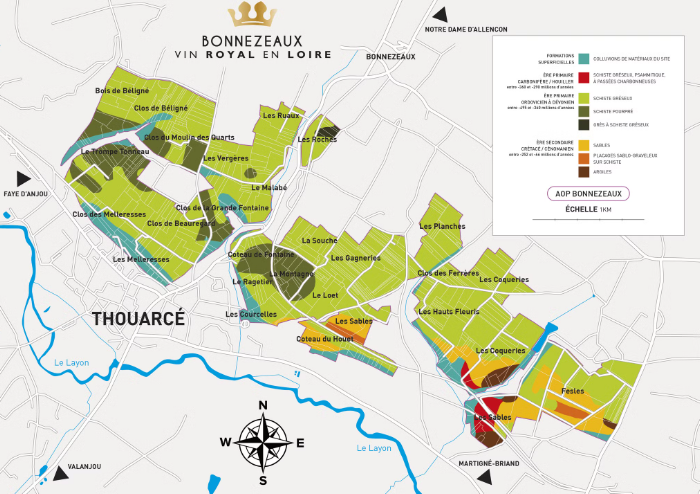All about Bonnezeaux
AOC Bonnezeaux, located in Anjou, produces sweet white wines exclusively from the Chenin grape variety. Thanks to its schist soils and noble rot, it offers wines rich in aromas of honey, candied fruit and spices, with lovely freshness and great complexity.
Key figures
Figures based on average harvests over the last 5 years
.80
Ha1600
Hl213k
Bottles25
hl/ha in yield37
Producers
Origins
History
The name Bonnezeaux could have several origins. It could be derived from the ferruginous mineral resurgences enjoyed by spa-goers since antiquity, or it could have Celtic origins, as the names Burniselus, Bonnezel or Bonnazel have been known since the 10th century. As early as the Middle Ages, the Plantagenets sent Bonnezeaux wines to the finest tables of the English, German and Dutch courts.
| 371 | Saint Martin | According to legend, it was in 371 that Saint Martin, bishop of Tours, planted the first chenin vine in Anjou. Since then, this grape variety has always remained in Anjou. The wines of Bonnezeaux are made from it |
| 1055 | First written trace | The first written trace of the existence of Bonnezeaux wines dates back to 1055. It is preserved in the Château de Fesles, was found in a document written by the Monks of Gué du Berge |
| 1951 | Creation of the AOC | the appellation d'origine contrôlée "Bonnezeaux" will be officially recognized by decree |
| 1990 | Notoriety | The appellation continues to be talked about, as it was the famous Pâtissier Gaston Lenôtre who was attracted to Bonnezeaux, to the point of acquiring a property in the appellation area. Another emblematic figure of this appellation was René Renou, former winemaker from Thouarcé who, when he was president of the INAO, propelled the appellation into the pantheon of France's great wines. |
| 2002 | Success | A 1996 Bonnezeaux wins the title of "World's Best Mellow Wine" at the Concours Mondial de Bruxelles. |
Presentation
The Bonnezeaux appellation area is located on a small part of a single commune on the right bank of the Layon: Thouarcé, on 3 south-facing hillsides. The vineyard covers 120 hectares in the commune of Thouarcé (Maine-et-Loire department) on the right bank of the Layon.
The Bonnezeaux grape is 100% Chenin and can benefit from the action of Botrytis cinerea.
- Color: White
- Style: Liquorous and mellow
- Varietal: Chenin
- Aroma: Acacia, verbena, orange peel, candied fruit, caramel, exotic fruit, spices
Soil and climate
South of the Loire, 20 km from Angers, the 80-hectare appellation area is located in a small part of a single commune on the right bank of the Layon: Thouarcé. The appellation extends over the steep slopes of its hillsides: "Les Melleresses", "Beauregard", "La Montagne", "Les Hauts Fleuris" and "Fesles". To the north of these three delimited hillsides lies a gently undulating plateau, with an average altitude of 90 meters, while the Layon river flows at an altitude of 29 meters. The soils of this appellation are of St Georges sandstone schist, with quartz and phtanite veins. The south and south-west exposure, and the presence of morning mists rising from the Layon, favor over-ripening of the grapes and the appearance of "noble rot". The climate of the Bonnezeaux appellation is of meso climatic influence (microclimate in which Mediterranean vegetation grows) allowing over-ripening and botrytization of the grapes.

Cultivation methods
Minimum density 4,000 vines/ha.
Yield 25 hl/ha
Technical constraints: Hand-picking with successive selections of over-ripe grapes showing concentration through the action or otherwise of noble rot. Control of production conditions at plot level.
Terroir and wines
The schist soils of Anjou noir, sandstone and clay confer a unique minerality and allow good water retention, favoring slow ripening of the grapes. The temperate oceanic climate, influenced by the Loire and its tributaries, creates ideal conditions for the development of noble rot (Botrytis cinerea), essential for the concentration of sugars and aromas. This unique combination of soil, climate and topography gives the wines the aromatic complexity and balanced acidity characteristic of the great mellow wines of Anjou.
